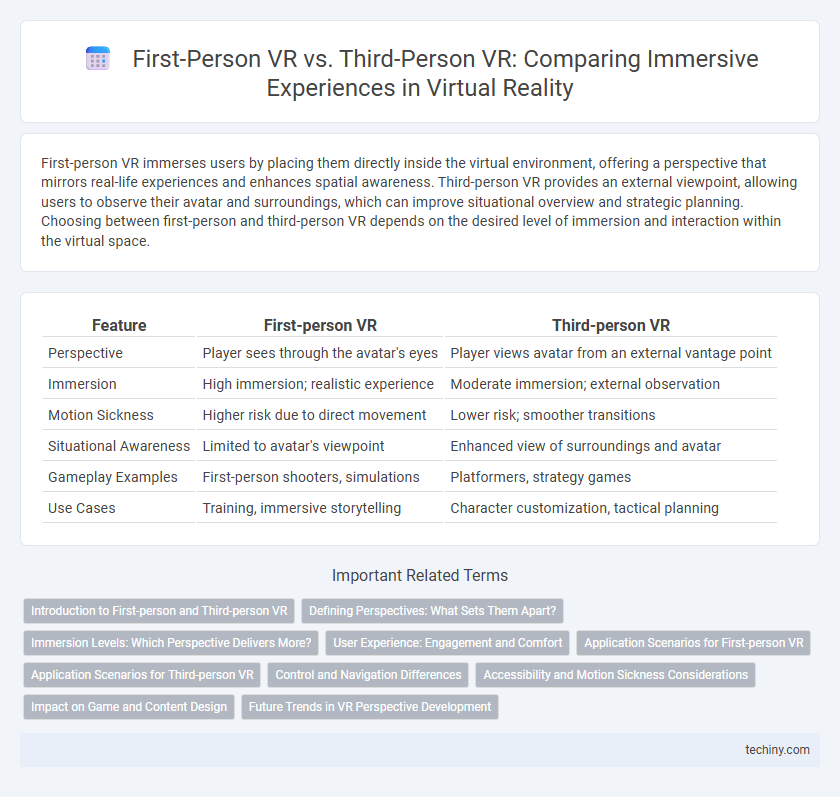First-person VR immerses users by placing them directly inside the virtual environment, offering a perspective that mirrors real-life experiences and enhances spatial awareness. Third-person VR provides an external viewpoint, allowing users to observe their avatar and surroundings, which can improve situational overview and strategic planning. Choosing between first-person and third-person VR depends on the desired level of immersion and interaction within the virtual space.
Table of Comparison
| Feature | First-person VR | Third-person VR |
|---|---|---|
| Perspective | Player sees through the avatar's eyes | Player views avatar from an external vantage point |
| Immersion | High immersion; realistic experience | Moderate immersion; external observation |
| Motion Sickness | Higher risk due to direct movement | Lower risk; smoother transitions |
| Situational Awareness | Limited to avatar's viewpoint | Enhanced view of surroundings and avatar |
| Gameplay Examples | First-person shooters, simulations | Platformers, strategy games |
| Use Cases | Training, immersive storytelling | Character customization, tactical planning |
Introduction to First-person and Third-person VR
First-person VR places users directly inside the virtual environment, offering immersive, real-time perspectives that mimic natural human vision and movement, enhancing presence and interaction. In contrast, third-person VR provides an external viewpoint where users observe their avatars or characters from a distance, allowing for strategic control and spatial awareness within the digital space. Both perspectives cater to different gameplay experiences, with first-person VR emphasizing immersion and embodiment, while third-person VR focuses on overview and tactical navigation.
Defining Perspectives: What Sets Them Apart?
First-person VR immerses users by placing them directly in the protagonist's viewpoint, enabling a highly interactive and personal experience with realistic spatial awareness. Third-person VR offers an external camera angle, allowing users to observe their avatar and environment simultaneously, enhancing strategic gameplay and situational understanding. This fundamental difference in perspective shapes user engagement, navigation, and emotional connection within virtual environments.
Immersion Levels: Which Perspective Delivers More?
First-person VR offers a higher level of immersion by placing users directly within the virtual environment, enabling natural interactions and a strong sense of presence. Third-person VR provides a detached viewpoint, often enhancing spatial awareness but reducing the feeling of being inside the virtual world. Studies show first-person perspectives significantly increase user engagement and emotional connection in VR experiences compared to third-person views.
User Experience: Engagement and Comfort
First-person VR offers immersive experiences by positioning users directly within the virtual environment, enhancing engagement through natural perspective and intuitive interactions. Third-person VR provides a broader viewpoint, allowing users to observe their avatars and surroundings, which can reduce motion sickness and improve spatial awareness for comfort. User comfort varies as first-person VR may cause disorientation for some, while third-person VR often creates a more controlled experience, balancing engagement with physical ease.
Application Scenarios for First-person VR
First-person VR offers immersive training simulations for medical professionals, allowing precise interaction with virtual anatomy and surgical tools. It enhances gaming experiences by providing players with a realistic viewpoint, increasing engagement and spatial awareness. First-person VR is also crucial in architectural walkthroughs, enabling users to explore designs from a human perspective for better design validation and spatial understanding.
Application Scenarios for Third-person VR
Third-person VR excels in applications such as training simulations, where users benefit from observing their avatar performing complex tasks to gain better spatial awareness and strategy planning. This perspective is ideal for collaborative environments and educational content, allowing users to monitor multiple characters and interactions simultaneously. Entertainment uses, like action-adventure games or virtual tours, leverage third-person VR to enhance narrative immersion and provide dynamic camera angles that deepen user engagement.
Control and Navigation Differences
First-person VR offers immersive control by allowing users to experience scenes from their own viewpoint, enhancing spatial awareness and intuitive navigation through head tracking and natural motion inputs. Third-person VR provides an external perspective, enabling users to control avatars or objects from a distance, which facilitates strategic planning and broader situational understanding but may result in less direct spatial immersion. Control schemes differ significantly, with first-person VR emphasizing embodied interaction and third-person VR relying on external camera manipulation and input devices for navigation.
Accessibility and Motion Sickness Considerations
First-person VR offers immersive experiences with natural head-tracking and spatial awareness but can increase motion sickness risk due to sensory mismatch. Third-person VR provides a broader perspective that reduces motion sickness by minimizing abrupt viewpoint shifts, making it more accessible for users prone to discomfort. Accessibility in third-person VR is enhanced by easier navigation controls and reduced physical strain compared to first-person VR's intense movement simulation.
Impact on Game and Content Design
First-person VR immerses players directly in the game world, emphasizing spatial awareness and intuitive interaction, which drives designers to focus on realistic environments and natural user interfaces. Third-person VR offers a broader perspective of the character and surroundings, enabling more strategic gameplay and complex narrative storytelling, influencing content creators to prioritize camera control and character animation. Both perspectives shape game mechanics and user experience uniquely, with first-person demanding high fidelity in sensory feedback and third-person requiring advanced scene composition and character dynamics.
Future Trends in VR Perspective Development
Future trends in VR perspective development are shifting towards hybrid models that combine the immersive presence of first-person VR with the strategic overview offered by third-person VR. Advanced eye-tracking, AI-driven camera systems, and real-time environment mapping will enhance perspective flexibility, enabling seamless transitions between viewpoints. These innovations aim to improve user engagement, situational awareness, and interactive storytelling in applications ranging from gaming to virtual training.
First-person VR vs Third-person VR Infographic

 techiny.com
techiny.com